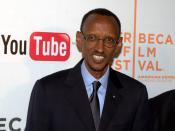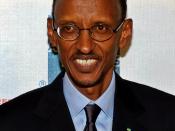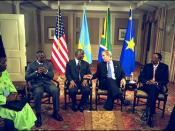The Central African country of Rwanda lies east of the Democratic Republic of the Congo and also borders the countries of Burundi, Tanzania and Uganda. The countries' total area is 26,338 square kilometres and is landlocked, which means it does not border the sea.
In 1959, the majority ethnic group, the Hutus, overthrew the ruling Tutsi king. Over the next several years, thousands of Tutsis were killed, and some 150,000 driven into exile in neighbouring countries. The children of these exiles later formed a rebel group, the Rwandan Patriotic Front, and began a civil war in 1990. The Tutsi rebels defeated the Hutu regime and ended the killing in July 1994, but approximately 2 million Hutu refugees - many fearing Tutsi retribution - fled to neighbouring Burundi, Tanzania, Uganda, and Zaire. Since then, most of the refugees have returned to Rwanda.
Rwanda is a republic country and is run by a presidential, multi-party system.
The current president of Rwanda is Paul Kagame, who won the election by seizing 94% of the votes after about half had been counted.
In Rwanda morbidity and infant-mortality rates are high. I believe this is due to the fact that access to potable water is a daily problem for more than half of the population and malaria is endemic. For females the average is 97.41 deaths/1,000 live births and for males the average is 107.66 deaths/1,000 live births. This gives an overall average of 102.61 deaths/1,000 live births. It also has an extremely low calorie consumption. The average daily per capita calorie supply (kilocalories) is 1861.
Education in Rwanda is fair compared to the fact that the country is a rural country with about 90% of the population engaged in agriculture. The percentage of people aged 15 and over that can read and write...


